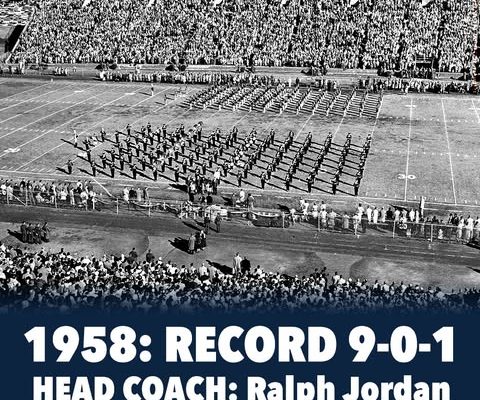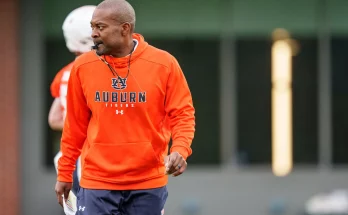It’s Official: Auburn Football Now Recognizes Nine National Championships After Honoring Seven More Historic Title Seasons
It’s a new era for Auburn football history. After decades of conversation, research, debate, and reflection, the university is officially recognizing seven additional national championships, bringing its total to nine. It’s not just a number—it’s a statement. It’s Auburn standing tall and honoring the legacy of greatness that’s been present on The Plains since the early 1900s. For the fanbase, alumni, former players, and current team members, it’s a powerful moment of validation, pride, and a long-overdue celebration of excellence.
The seven newly claimed titles—1910, 1913, 1914, 1958, 1983, 1993, and 2004—join the previously recognized championships from 1957 and 2010. Each of these seasons represents a team that, in its time, achieved something extraordinary. And now, Auburn is officially acknowledging that these squads were named national champions by recognized polls or selectors that were considered legitimate sources in their respective eras. This doesn’t rewrite history; it expands the way Auburn tells its story and honors teams that helped define the program across generations.
Let’s break it down. In 1910, Auburn’s defense was absolutely dominant. That team, led by coach Mike Donahue, didn’t allow a single point all season. They outscored opponents 176-0, finishing with a perfect record and establishing one of the most suffocating defenses in college football history. The Billingsley Report, a respected mathematical selector, later recognized that 1910 team as national champions. Fast forward just a few years to 1913, when Auburn again posted a flawless season. The team went 8-0 and was awarded the national title by the National Championship Foundation. In 1914, Auburn didn’t quite go undefeated, but their body of work was once again strong enough to earn a national title designation from James Howell’s rankings, another respected selector.
Moving into the modern era, 1958 saw Auburn put together one of its most dominant seasons under legendary coach Shug Jordan. Although LSU was named the AP champion that year, Auburn was named national champs by the Montgomery Full Season Championship system. Then comes 1983, a season that still sparks debates today. Under Pat Dye, Auburn faced the toughest schedule in the country, finishing 11-1 while beating eight bowl teams and winning the Sugar Bowl over Michigan. Miami, who played a weaker schedule and had one loss, was crowned the AP champion, but several other selectors, including the New York Times computer rankings, gave Auburn the nod.
The 1993 team holds a special place in Auburn history. Despite being banned from television and postseason play due to NCAA sanctions, that team, led by Terry Bowden, went 11-0. It was a season fueled by defiance, grit, and team unity. While they couldn’t play for an official title, they were recognized by the National Championship Foundation and other sources as the best in the nation. It’s a team Auburn fans have long celebrated as champions in spirit—and now, they’re officially champions in name as well.
And of course, there’s 2004. That squad, coached by Tommy Tuberville, went 13-0 and beat four top-10 teams, but was infamously left out of the BCS National Championship game in favor of USC and Oklahoma. While the Trojans eventually had their title vacated due to NCAA violations, Auburn never received a shot at the crown. Still, multiple computer rankings, including the GBE and Darryl W. Perry systems, named Auburn as the national champion. Now, that incredible team—featuring Cadillac Williams, Ronnie Brown, Jason Campbell, and a loaded defense—is finally getting its due.
For years, fans have pointed to these seasons as worthy of recognition, especially in a sport that historically crowned champions in fragmented ways. Before the College Football Playoff and even the BCS, national titles were awarded by various polls, computers, and systems. That meant multiple teams could be crowned in the same year, depending on who you asked. Auburn, like many other major programs, has gone back to review its history and officially claim the titles that were rightfully theirs according to accepted selectors.
What makes this moment especially meaningful is that it honors the work of players and coaches who poured everything into Auburn football, often in eras where recognition was hard to come by. These weren’t just good teams—they were dominant, resilient, and historic. They faced challenges both on and off the field, from wartime America to NCAA restrictions to flawed postseason systems. Yet they still won. They still gave Auburn fans memories that have lasted generations. And now, those memories will be forever etched into the program’s official legacy.
The move also gives Auburn a louder and prouder voice in the ongoing conversation around college football’s elite programs. With nine claimed national titles, Auburn now stands on more equal footing with other powerhouse schools that have retroactively claimed championships in recent years. Programs like Alabama, Texas A&M, and USC have done similar reviews of their past and embraced their full history. Auburn’s decision isn’t about keeping up—it’s about finally embracing what was already there.
The displays inside Jordan-Hare Stadium will soon reflect this shift. Each newly recognized championship year will be honored, not just with banners, but with respect. That visual representation will serve as a reminder to current players and fans of what’s possible at Auburn. It’s not just about 2010. It’s about 1913, 1958, 1983, and beyond. It’s about the long tradition of excellence that has always been part of the Auburn DNA.
This update to Auburn’s official record isn’t just a numbers game—it’s a cultural moment. It shows that Auburn values its past, even the parts that were overlooked or dismissed for too long. It shows that the hard work of past generations will not be forgotten. It unites the different eras of Auburn football under one banner of championship legacy and gives future teams a greater sense of purpose and pride when they suit up and step onto Pat Dye Field.
The Auburn community has always been fiercely loyal and incredibly proud, and now there’s even more to celebrate. Former players are sharing their excitement, fans are digging through old highlights, and a whole new chapter of school pride is being written. From Toomer’s Corner to Tiger Walk, from the 1910 defense to the 2004 undefeated team, Auburn’s history just got richer, deeper, and more complete.
Recognizing these championships doesn’t change the past—it honors it. It gives Auburn the platform it deserves as one of the most storied programs in college football and brings justice to teams that helped shape what Auburn football is today. It’s a reminder that greatness has been part of Auburn’s story from the beginning, even if the spotlight wasn’t always there. Now, the spotlight is shining where it belongs.
War Damn Eagle—times nine.



